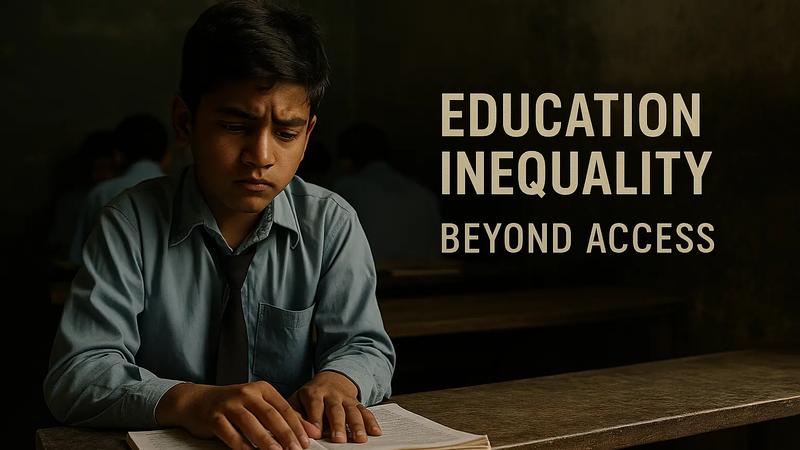Education Inequality Beyond Access — A RAW, UNFILTERED WAKE-UP CALL

We often talk about education inequality in terms of access. But the real story starts after the access is given. The real challenge? Turning access into actual learning. It’s not just about schools or devices — it’s about motivation, exposure, and belief.
1. The Digital Divide Isn’t Just About Devices
What people think: Give tablets and internet to rural areas, and education gaps are solved.
Reality: Devices are there — but learning isn’t happening.
📊 ASER 2023 reports: Over 70% of rural children have access to smartphones, but less than 30% use them regularly for learning.
Why? No guidance, no digital literacy, no purpose.
We don't need just digital access. We need digital mentorship.
2. Teachers Are Often Qualified — But Motivation is Missing
Common narrative: Rural schools have unqualified or absent teachers.
Ground reality: Many government school teachers are well-educated, trained, and capable.
But what’s missing?
Recognition. Monitoring. Motivation.
When there's no accountability, even the most talented teachers lose purpose.
Himachal Pradesh is proof: Government schools outperformed private ones through regular training and local engagement.
When teachers are trusted and empowered, they shine.
3. Parental Involvement and Cultural Gaps
In many rural homes, education is tolerated, not celebrated.
Why?
📌 Many parents are not literate or confident to guide their children.
📌 Education feels like a long-term gamble vs. short-term income from farming or labor.
But it’s changing.
💡 In Maharashtra, “Mother-Teacher Meetings” in villages created learning collectives. Mothers who never went to school are now checking homework and asking questions.
Empower the parent. You empower the child.
4. Early Childhood Learning is Ignored
This is where the gap starts — not in Class 1, but before it.
Anganwadi centers lack resources, and ages 0–6 — the most crucial years — are forgotten.
By Class 3, many children still can’t read Class 1 books.
✨ The Mo School program in Odisha focused on early literacy and brought in alumni support — showing that change is possible.
5. Exam-Focused System Kills Curiosity
Across both rural and urban schools, we’ve created exam-cracking machines, not problem-solvers.
Result?
Students pass exams but struggle in real life — no confidence in speaking, creating, or thinking critically.
We need to stop measuring intelligence only through marks.
🌱 Programs like Atal Tinkering Labs (ATL) are planting seeds of creativity and innovation, even in government schools.
Let students build, question, present — not just memorize.
6. Migration Breaks the Learning Cycle
In many regions, families migrate seasonally for work.
Children are either taken along (disrupting their schooling) or left behind without support.
This leads to:
- Interrupted learning
- Early dropouts
- Lost potential
🚍 In Bihar, pilot mobile classrooms followed migrating families — a small step to keep learning alive during migration.
We need more such solutions that follow the child, not just the school.
7. Exposure Is Missing
Urban kids visit science fairs, coding bootcamps, career counsellors.
Rural kids often don’t even know what lies beyond farming, teaching, or construction.
🌟 That’s not lack of intelligence — it’s lack of exposure.
Mentorship programs like Mentor Together bring working professionals to students — to open minds, expand dreams, and light sparks.
So What Can Be Done?
Government Must:
- Monitor, train, and incentivize teachers.
- Strengthen early education through better-equipped Anganwadis.
- Fund practical, digital literacy — not just print more textbooks.
Community Must:
- Create Education Sabhas — village meetings to discuss why education matters.
- Encourage local youth and alumni to return and mentor.
Tech Must:
- Build offline-first, local-language learning apps.
- Use YouTube + WhatsApp to deliver small lessons in regional dialects.
Final Thought
This isn’t just about missing teachers or money.
Often, it’s a lack of belief, of early nurturing, and of role models.
The real revolution in education won’t just come from policies or funds — it’ll come from people. From the inside out.
Let’s not wait for someone else to fix it.
Change can start in one classroom, one teacher, one mother, one mentor.
Let’s not just educate.
Let’s inspire.
Let’s believe — and make them believe — that learning has power, and that power belongs to everyone.